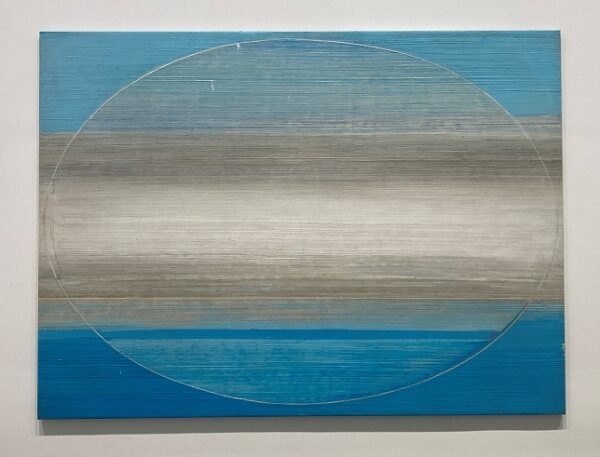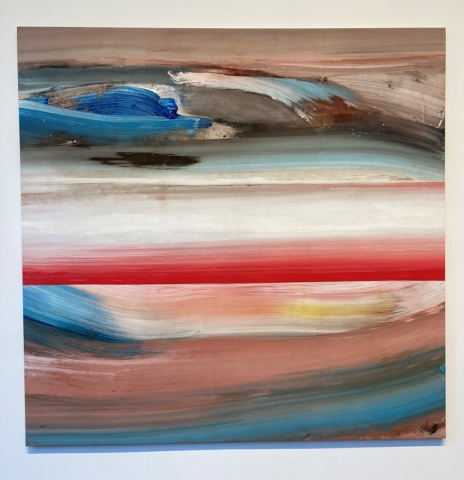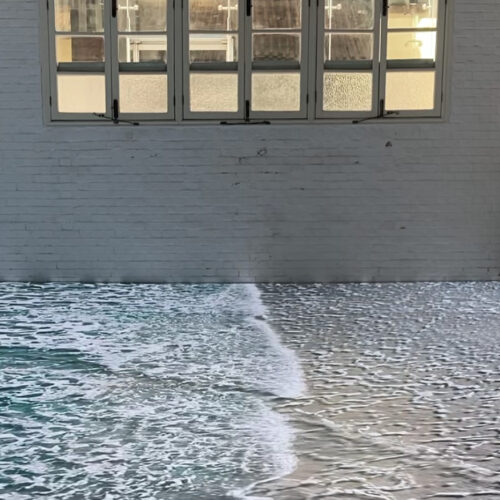‘Without a Doubt’, an exhibition of eight generously scaled paintings by Abstract Expressionist artist Ed Clark, is on show at Hauser & Wirth in London. Epic strokes of colour feature throughout, achieved through Clark’s pioneering use of a push-broom to apply paint. However, this is not an “AbEx” visual frenzy; the works hold a simultaneous strength and softness. Clark’s use of white tempers his otherwise vibrant colour palette, and his paint application is considered, administered with care for composition, whether it be regimented and linear or sweeping and kinetic. Filling the walls of the gallery, the works create a space for viewers to ruminate on the core subject matter at hand – paint itself.
Born in New Orleans in 1926, Clark studied, lived and worked in Paris before moving to New York in 1957, resulting in influences from both European Modernism and American Abstract Expressionism. With a unique focus on colour, form and materiality, Clark became an innovator of the New York School scene and is considered one of the first artists to move beyond the traditional rectangle and exhibit a shaped canvas – an oval example, Untitled (1970), is on view in this exhibition. Clark’s concern with paint as a subject in and of itself set him on a unique path of artistic invention.

The eight works on show in ‘Without a Doubt’ demonstrate Clark’s experimentation with paint application over a 30-year period, from the 1970s to the 1990s. An earlier piece, Blue Umber (1975) (fig 1), is exemplary of the more linear, regimented technique which Clark began with. Paint is brushed horizontally across the canvas, with blue applied in a thick line across the top and base, sandwiching a central strip of grey and white. Within the rectangular canvas frame, a perfectly oval white line cuts through the linearity, segmenting the canvas with almost mathematical precision. In comparison, later works such as Untitled (Paris) (1998) and Untitled (1990s ca) (fig 3) show a clear departure from the application of paint strokes in a singular direction. Instead, they boast a sense of dynamism and spontaneity with colour swept over the canvas in bold, multi-hued arcs. Splats of paint are distinct, likely a result of the speed with which Clark maneuvered the push-broom. While the paint strokes remain constant in terms of their striking scale throughout all of the works on display, there is a discernible difference in the drive that created them – starting controlled, then becoming increasingly uninhibited.
It must be noted, though, that the later works on display also suggest that Clark did not neglect his earlier approaches entirely, arguably combining both dynamic strokes together with the more precise, straight lines of his early canvases. Untitled (1996-97 ca) (fig 4) greets you as you enter the gallery. This later piece is indicative of Clark’s unrestrained approach, with thick waves of blue, white, brown and black freely applied. However, the work’s looseness is jarred by a central strip of red and white paint, which has a hard, straight edge that cuts horizontally through the canvas. Exemplified here is a merging of painterly methods that together create a subtle tension between freedom and control. Paris series #2 (1987) (fig 5) and Untitled (1990s ca) (fig 3), both later works, also contain this straight, central strip, which seems intentional for compositional purposes. Here, the central strip aids a sense of symmetry and acts as an anchor for the dynamic, arching strokes surrounding it. It is also worth mentioning, Untitled, a 1990 canvas (fig 6), sees a near total return to the serene composition of Blue Umber (fig 1) and Untitled (1976 ca.) (fig 2), indicating that Clark was still engaged with straight lines and precision even latterly in his practice.

‘Without a Doubt’ offers an insight into Clark’s enthused exploration into the possibilities of paint over three decades. The pieces on display illustrate a diverse and expanding repertoire of strokes, from considered and linear to free and arching, with Clark utilising them independently and combining them together to create both tranquil and dramatic compositions. The pieces are not hung in the gallery chronologically, which is apt given there is no clear-cut move from one stroke style to another. Instead, the hanging offers the opportunity to see elements of earlier paintings harked back to in later works, as well as Clark’s discovery of new methods of paint application along the way. In all, this is an exhibition about paint and paint alone, offering a colourful, visually stimulating escape, and attesting to the boundless, explorative possibilities that a stroke of paint can offer.
On display at Hauser & Wirth’s London space until 20 April 2022.






